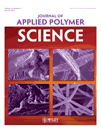Preparation and properties of polyamide 6 fibers prepared by the gel spinning method
Abstract
Polyamide 6 (PA6) fibers were prepared by CaCl2 complexation and the gel spinning technique. PA6 was partially complexed with CaCl2 for the purpose of suppressing interchain amide group hydrogen bonding. The fibers were characterized with scanning electron microscopy, X-ray diffraction (XRD), differential scanning calorimetry (DSC), and Fourier transform infrared (FTIR) spectroscopy. In the gel spinning process, a mixed tetrachloroethane and chloroform solution was chosen as the coagulation bath after a comparison of different types of solutions. From our investigation of the morphology, structure, and mechanical properties of gel-spun and hot-drawn fibers, it was indicated that the modulus and tensile strength increased with increasing draw ratio, the orientation of the fibers was improved, and the cross section of the PA6 gel fibers became more smooth and tight. The results from the XRD, DSC, and FTIR tests indicated that calcium metal cations complexed with the carbonyl oxygen atoms of PA6. The maximum modulus and tensile strength values obtained in this study were 28.8 GPa and 413 MPa, respectively, at a draw ratio of 8. © 2011 Wiley Periodicals, Inc. J Appl Polym Sci, 2011




